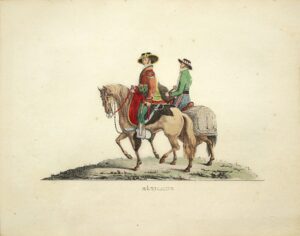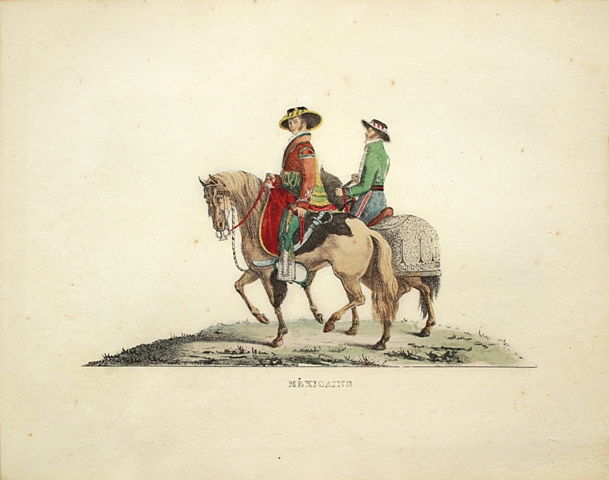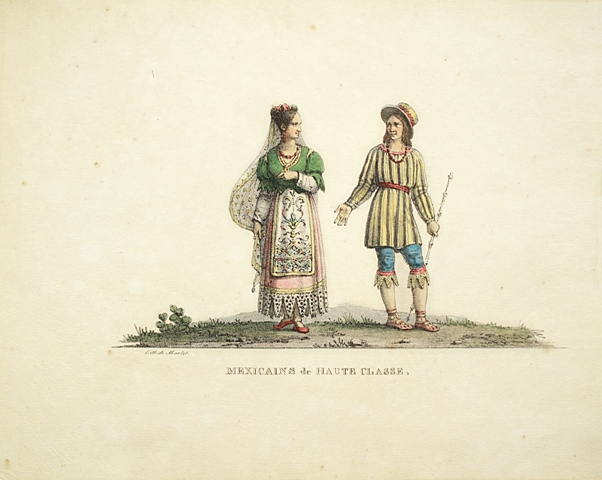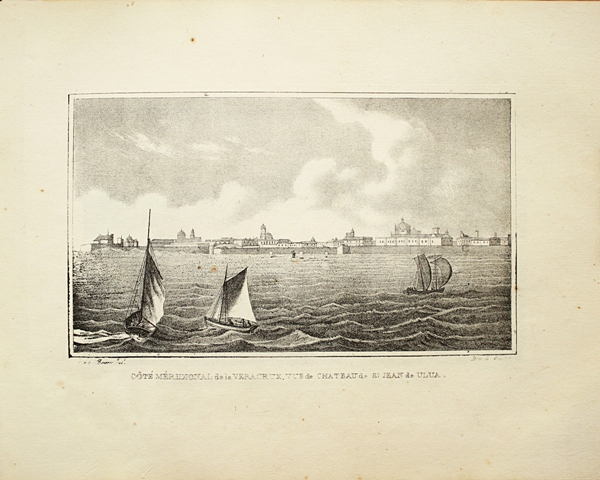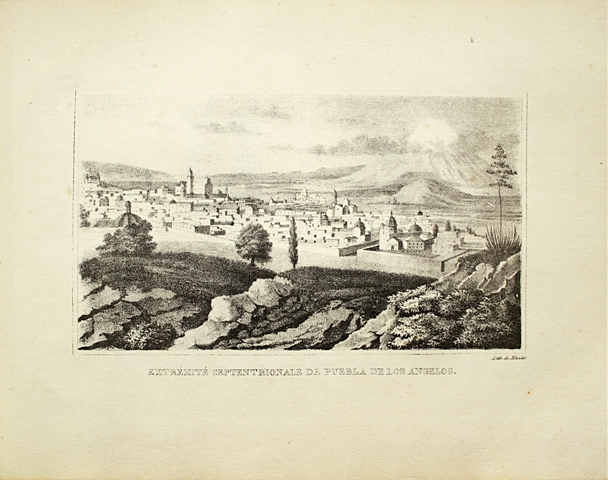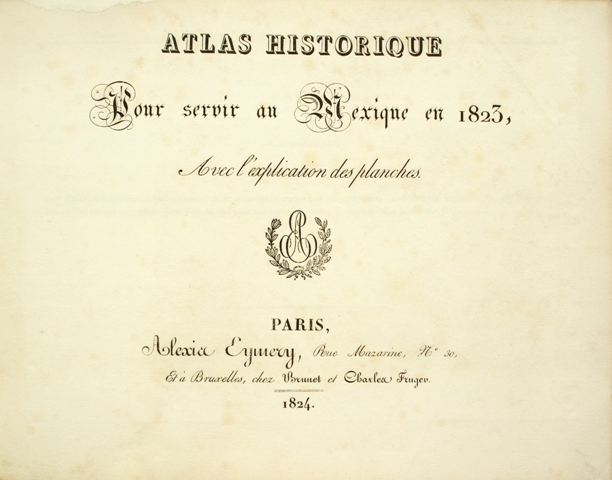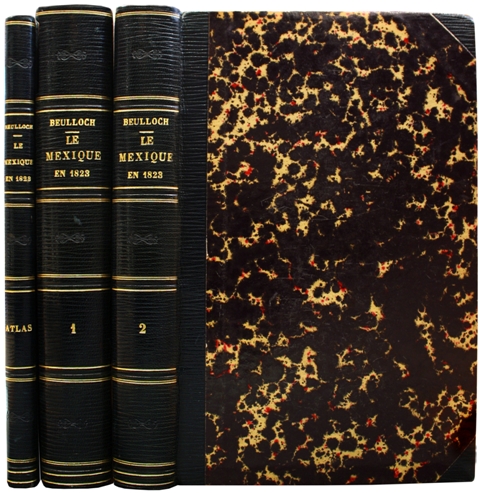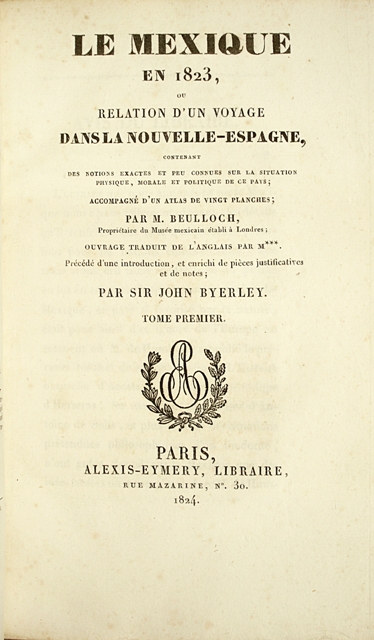BEULLOCH (or BULLOCK), William. Le Mexique en 1823, ou relation d’un voyage dans la Nouvelle-Espagne, contenant des notions exactes et peu connues sur la situation physique, morale et politique de ce pays ; accompagné d’un atlas de vingt planches ; par M. Beulloch, Propriétaire du Musée mexicain établi à Londres ; ouvrage traduit de l’anglais par M***. Précédé d’une introduction, et enrichi de pièces justificatives et de notes ; par Sir Jon Byerley. Paris, Alexis-Eymery, 1824. [With:] Atlas historique Pour servir au Mexique en 1823, avec l’explication des planches. Paris, Alexis-Eymery et Bruxelles, chez Brunet et Charles Frugev, 1824.
2 volumes 8vo [206 x 133 mm and atlas 263 x 203 mm] of: I/ (2) ll. with the half-title and the title, iii pp., (1) bl.p., lxxii pp. for the introduction and the foreword, 364 pp.; II/ (2) ll. with the half-title and the title, 360 pp. [i.e. 370 pp.], 1 l. of errata; and an small 4to oblong atlas of: 11 pp., 20 plates including 2 folding maps, 1 folding plate and 6 watercolored pl. Bound in posterior dark blue quarter-calf, flat spines decorated. Printed wrappers and spines bound in the 3 volumes.
First French edition of this important relation of a travel to Mexico, the first one made by an Englishman since Father Thomas Gage in 1640. Sabin, 9140 and 9141; Chadenat n°2050; Brunet, VI, 1116, n°21063; Abbey 667.
It is the very first travel relation following the signing of the declaration of independence of Mexico on September 28th 1821. As such, volume II includes the constitutional Act of the Mexican Confederation, the Mexican Constitution in Spanish and in French.
“A work that has become very rare.” (Chadenat n°2050).
It was published the same year as the first English edition. The French one was an immediate success.
“One of the first travelers to publish in France the story of his journey after the Independence is the Englishman William Bullock […]. A wealthy jeweler and antique dealer, owner of a museum in Liverpool then in London, William Bullock goes to Mexico at the end of 1822 to study the country and do some research related to his archeological and mineralogical interests. He leaves Portsmouth on December 11th 1822. After an abnormally long travel, his ship reaches the port of Veracruz on February 24th 1823, at a difficult time because, after the signing of the Plan of Casa Mata that was to hasten the fall of Iturbide, the Spanish still holds the castle of San Juan de Ulúa. After a few inconvenience because of the particular situation of the city, he leaves Veracruz and reaches Mexico where he arrives while Iturbide just abdicated (on March 19th 1823). He dedicates many pages to remarks about the Mexican society, habits and customs, as well as farming, industry and trade of the country. He leaves Mexico on July 9th 1823, after a 6 months stay. After a stop in Havana, he arrives in Portsmouth on November 8th 1823. Bullock’s work is both interesting and historically important. Being one of the first great witnesses of the situation of independent Mexico, he appears as a enlightened mind, knowing well Mexico’s history, the pre-Columbian civilization and art, the Conquest and the Colony, the great classical works that, over the centuries, have made it known, as well as the travelers who came before him. Wise, pragmatic, curious about everything, the English traveler is interested in archeology, mineralogy, botany and medicine as well as economical and social matters, as shown by the long Introduction he dedicates to these questions. According to the French “Bookseller” who expresses himself in the “Foreword” opening the book, this “cutting” work will be “useful to the French public” as it shows “the considerable changes” that took place since A. von Humbold’s stay. In addition, an “historical Atlas” of twenty plates depicting human kinds, costumes, sites, archeological pieces increases quite a bit its interest. Republished several times in English and in French, present in most of the bibliographies, used and quoted until the Intervention by observers and travelers, Bullock’s “Mexico in1823″ remains one of the essential sources of knowledge of Mexico in the first years of Independence.” Guy-Alain Dugast, La tentation mexicaine en France au XIXe siècle, p 90-92.
“Mexico, this country so favored by nature was, so to speak, ignored by Europe (…). Acosta’s natural History, Herreras’ historical Diary, Antoine de Solis’ pompous narrations (…) have hardly given anything about Mexico but fake or incomplete ideas. With Mr. von Humboldt, we are enlightened by truth and science; but since this erudite composed his work, considerable changes have occurred in the political situation of New Spain, in nature and in the forms of its government, in the customs and opinions of the inhabitants. It was for Sirs Beulloch and John Byerley to make know these changes” (Foreword).
Bulloch accumulated an important collection of natural objects and curiosities for a Mexican museum project in London. He can be considered as a pioneer of the intercultural exchange between England and Mexico: his researches aroused the interest for the art, history and the Mexican people, opening a breach to the countless English traveler-archeologists.
This travel relation is embellished with a lithographed atlas by Jean-Henry Marlet after original drawing made in situ by Beulloch, composed of a portrait of the author and 20 plates: 2 maps of Mexico, 10 views of towns and Mexican landscapes, 2 plates of Aztec sculptures and 6 plates of costumes contemporary watercolored.
This edition contains two more plates than the English edition and is the most illustrated of all editions.
A beautiful copy of this important relation of a journey to Mexico, embellished with a very beautiful atlas illustrated in color.
